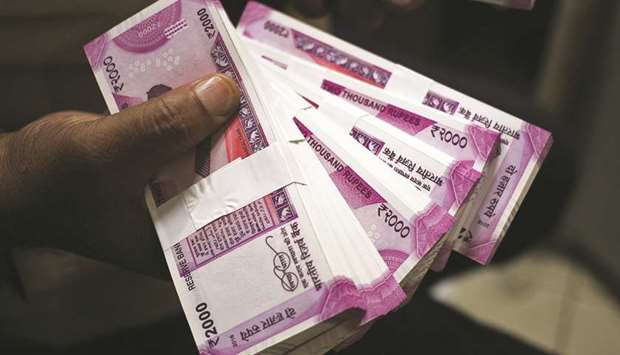India stocks declined at the end of a volatile trading day as investors weighed the gradual resumption of business activity against a steady rise in new coronavirus cases, ahead of the quarterly earnings season starting today.
The S&P BSE Sensex fell 0.9% to 36,329.01 at the close in Mumbai, after rising as much as 0.4% earlier.
The NSE Nifty 50 Index also slipped 0.9%. The measures have risen for the past five days and are just short of breaking through the 200-day moving average, a key technical barrier.
A gauge of smaller company stocks has already breached the indicator.
Signs of economic growth are re-emerging in India as business gradually reopens from a prolonged lockdown. Still, India’s coronavirus epidemic has become the third biggest in the world as infections surged after containment was eased. A collapse in inflows to equity mutual funds in the month of June also weighed on sentiment.
“We are at a stage where valuations are very high and that’s made investors more sensitive to any negative data,” said Sameer Kalra, an investment strategist at Target Investing in Mumbai. “July data on inflows to mutual funds will be closely scrutinized now.”
“Investors would want to know the outlook for business going ahead, as most expect the earnings impact to last for at least two quarters,” said Chokkalingam G, head of investment advisory at Equinomics Research & Advisory Pvt in Mumbai.
Earnings for most companies suffered between April and June due to the lockdown aimed at curbing the spread of coronavirus. Tata Consultancy Services Ltd, Asia’s biggest software exporter, will announce results today.
The yield on the benchmark 10-year government bond fell to 5.78%. The rupee depreciated 0.1% to 75.0225 per US dollar.
Sixteen of 19 sector sub-indexes compiled by BSE Ltd fell, led by a gauge of real estate companies.
Reliance Ltd was the biggest drag on the index, slipping 1.5%, Bajaj Finance Ltd had the biggest drop, declining 4.5%; IndusInd Bank Ltd had the largest gain, rising 5.1%.
Meanwhile the rupee depreciated 9 paise to settle at 75.02 (provisional) against the US dollar yesterday tracking volatile domestic equities, rising crude oil prices and strengthening American currency.
While foreign fund inflows supported the rupee, factors like strong dollar, volatile domestic equities and rising Covid-19 cases dragged the local unit down, Forex traders said.
The rupee opened on a positive note at 74.88 at the interbank forex market, but lost ground and settled for the day at 75.02 against US dollar, down 9 paise over its last close.
It had settled at 74.93 against the US dollar on Tuesday.
During the four-hour trading session, the domestic unit witnessed an intra-day high of 74.87 and a low of 75.05 against the US dollar.
The dollar index, which gauges the greenback’s strength against a basket of six currencies, rose 0.01 per cent to 96.89.
Meanwhile signs are emerging that India’s $277bn stimulus is helping reopen the bond market to smaller borrowers and easing the nation’s credit crunch.
Issuance of local-currency corporate notes graded A+ and lower rose to a 15-month high of Rs51.7bn ($690.5mn) in June. Such offerings had plunged in April and May as the coronavirus pandemic and the world’s largest lockdown to contain it battered investor demand for risky assets in India.
The nation’s small businesses, which form the bedrock of Asia’s third-biggest economy, need to build cash buffers and restore operations as economic growth this year is set to shrink for the first time in four decades.
India’s support measures have also helped cut borrowing costs for weaker borrowers, with the average yield on A rated three-year company notes close to the lowest level since at least 2004.

The rupee weakened to 75.02 against the US dollar yesterday tracking volatile domestic equities, rising crude oil prices and strengthening American currency
